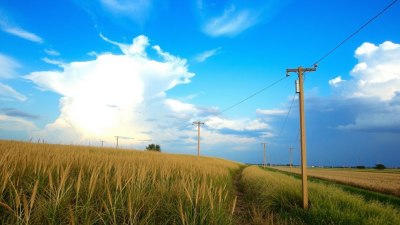How Forecasters Use Ensemble Models to Improve Accuracy
Explore how ensemble models enhance forecasting accuracy by combining multiple predictions in weather, finance, and more.

Image created with Flux Schnell
Forecasting plays a crucial role in many fields such as meteorology, finance, economics, and supply chain management. Accurate predictions enable better decision-making, risk mitigation, and resource allocation. However, forecasting is inherently challenging due to the uncertainty and complexity of real-world systems. To improve accuracy, forecasters increasingly rely on ensemble models, which integrate multiple individual predictions into a single, more reliable forecast.
What Are Ensemble Models?
Ensemble models are a class of forecasting methods that generate predictions by combining the outputs of multiple models or simulations. Instead of relying on a single model's forecast, ensemble approaches aggregate diverse predictions to capture a broader range of possibilities and reduce errors. This method leverages the principle that collective judgment, when properly integrated, often outperforms individual opinions or models.
There are various strategies to combine the outputs of individual models. Some ensembles simply average the results, while others assign weights based on historical performance or use more complex algorithms to fuse predictions. The common goal is to improve robustness and accuracy over any single model.
Why Use Ensemble Models?
The uncertainty inherent in forecasting arises from incomplete data, model imperfections, chaotic system dynamics, and unforeseen events. Relying on just one model may produce biased or overly confident predictions. Ensemble models mitigate these risks in several ways:
- Reduced Overfitting: Individual models may overfit past data, capturing noise rather than signal. Ensemble averaging smooths this effect, leading to better generalization.
- Incorporating Model Diversity: Different models use distinct structures, assumptions, and datasets. By combining them, ensembles leverage complementarity and offset individual weaknesses.
- Improved Error Estimation: Ensembles help quantify forecast uncertainty by showing the variability across member predictions.
- Enhanced Adaptability: Ensembles can integrate new models or data sources dynamically, improving forecasting as information evolves.
Types of Ensemble Models
Ensemble forecasting approaches vary depending on the domain and modeling framework. Some commonly used ensemble types include:
- Simple Average Ensembles: The most straightforward method involves averaging predictions from multiple models equally. This reduces variance and often enhances accuracy relative to the best individual model.
- Weighted Ensembles: Models are assigned weights based on their past accuracy or reliability. The weighted sum produces the final forecast, emphasizing better-performing models.
- Bootstrap Aggregating (Bagging): This technique generates multiple models by training on randomly sampled subsets of data. The ensemble averages their predictions to reduce variance and avoid overfitting.
- Boosting: Boosting sequentially trains models focusing on errors made by previous models. The final ensemble is a weighted combination prioritizing difficult-to-predict cases.
- Bayesian Model Averaging: Models are combined according to their posterior probabilities based on observed data, providing a probabilistic interpretation of forecasts.
- Stacking: Outputs from base models are used as inputs to a higher-level model, which learns the best way to combine predictions.
Ensemble Forecasting in Meteorology
Weather forecasting is one of the earliest and most extensively developed fields to adopt ensemble techniques. Atmospheric systems are inherently chaotic and sensitive to initial conditions, which limits the accuracy of deterministic forecasts.
Numerical Weather Prediction (NWP) models simulate atmospheric physics using complex equations. Slight variations in input data or model parameters can produce drastically different outcomes. To address this, meteorologists run multiple simulations with varied initial conditions and model representations, creating an ensemble of forecasts.
The ensemble captures a range of plausible future states, allowing forecasters to assess the probability of events like precipitation, storms, or temperature extremes. For example, the Global Ensemble Forecast System (GEFS) and the European Centre for Medium-Range Weather Forecasts (ECMWF) ensemble model provide probabilistic forecasts that inform governments, airlines, and emergency management agencies.
Beyond accuracy, ensembles help quantify forecast uncertainty—a critical consideration for planning and risk assessment. Decision-makers can evaluate confidence intervals or likelihoods instead of relying solely on a single deterministic outcome.
Financial Forecasting and Ensemble Models
Financial markets exhibit volatility and complex interactions that challenge predictive modeling. Stock prices, interest rates, and economic indicators respond to myriad factors including macroeconomic trends, geopolitical events, and investor sentiment.
Traditional single-model approaches often fail to capture nonlinearities or regime shifts. Ensemble models remedy this by merging diverse methodologies such as time-series models, machine learning algorithms, and econometric frameworks.
Portfolio managers and quantitative analysts use ensembles to forecast asset returns, risk measures, or market trends. For instance, combining neural networks, support vector machines, and random forests into an ensemble allows detection of subtle patterns that may otherwise be missed.
Weighted ensembles based on recent model performance help adapt to changing market conditions. Incorporating ensemble forecasts in investment strategies can improve returns and reduce exposure to adverse market movements.
Ensembles in Supply Chain and Demand Forecasting
Forecasting demand is vital for logistics, inventory management, and production planning. Accurate predictions reduce holding costs, prevent stockouts, and enhance customer satisfaction.
Demand patterns can be nonlinear, seasonal, and influenced by promotions, economic cycles, or competitor actions. Single forecasting models like moving averages or exponential smoothing may be insufficient on their own.
Ensemble models combine statistical methods, machine learning techniques, and domain knowledge to capture these complexities. For example, ensembles may integrate ARIMA models, gradient boosting trees, and expert judgment to predict sales for different product categories.
The combined forecast improves robustness across varying scenarios and accounts for both long-term trends and short-term fluctuations. Some advanced supply chain systems employ real-time data feeds in ensemble frameworks for dynamic adjustments to forecasts.
Challenges of Ensemble Forecasting
While ensembles offer significant benefits, implementation is not without challenges:
- Computational Cost: Running multiple models or simulations can be resource intensive, especially for high-resolution weather or economic models.
- Data Requirements: Diverse and quality data inputs are needed to effectively train and run multiple models.
- Model Correlation: If ensemble members are highly correlated, benefits diminish as there is less independent information to combine.
- Weighting and Integration: Determining optimal weights or combining rules for diverse models remains complex and context-dependent.
- Overconfidence Risks: Misinterpretation of ensembles can lead to overconfidence if variability is misunderstood or underestimated.
Despite challenges, advances in computing power, big data availability, and algorithmic innovations continue to enhance ensemble methodologies.
Evaluating Ensemble Forecasts
Assessing the performance of ensemble models requires metrics that account for both accuracy and reliability of probabilistic predictions.
Common evaluation tools include:
- Mean Absolute Error (MAE) and Root Mean Squared Error (RMSE): Measure the average magnitude of forecast errors.
- Continuous Ranked Probability Score (CRPS): Evaluates the accuracy of probabilistic forecasts by comparing cumulative distribution functions.
- Brier Score: Measures the accuracy of predicted probabilities for binary events.
- Rank Histograms and Reliability Diagrams: Assess whether ensemble spread matches observed variability, indicating calibration.
Regular evaluation guides tuning of ensemble composition, weighting, and modeling approaches to achieve ongoing improvements.
Case Study: Ensemble Forecasting of Hurricane Tracks
Hurricane predictions illustrate the real-world impact of ensemble methodologies. Predicting the path and intensity of tropical cyclones is crucial to issuing timely warnings and mobilizing evacuations.
Operational centers use ensembles that combine outputs from different atmospheric models and perturbations of initial conditions. This produces a 'cone of uncertainty' defining likely storm trajectories rather than a single deterministic line.
Ensemble forecasts reveal not only the most probable path but also alternative scenarios, helping decision-makers weigh risks and prepare accordingly. Historical analyses show that ensemble guidance significantly outperforms single-model forecasts in reducing track errors.
Future Directions in Ensemble Forecasting
Research continues to expand ensemble forecasting capabilities by integrating artificial intelligence, data assimilation techniques, and multi-disciplinary data sources.
For example, hybrid ensemble frameworks combine physics-based models with machine learning predictors to refine forecasts. Techniques like deep learning feature extraction enhance model diversity.
Real-time updating and adaptive weighting schemes can improve responsiveness to new data and changing conditions. Additionally, ensembles are being applied to emerging areas such as epidemiology, energy demand forecasting, and climate change projections.
As computational resources grow and data availability increases, ensemble forecasting is poised to become even more integral across domains that require reliable predictions.
Ensemble models represent a powerful approach to improving forecasting accuracy and reliability by combining multiple predictions. They capitalize on diversity and reduce individual model biases, proving especially valuable in complex, uncertain systems. From weather forecasting to finance and supply chain management, ensembles enable probabilistic insight, better decision-making, and a clearer understanding of uncertainty. While challenges such as computational demand and optimal weighting remain, advances in technology and methodology continue to enhance their effectiveness. Practitioners who leverage ensemble methods position themselves to achieve more robust and credible forecasts in an unpredictable world.











